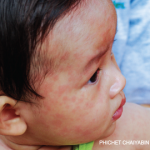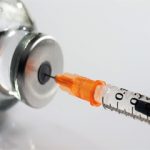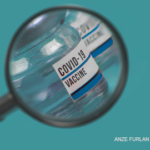 Despite the presence of a highly effective vaccine, measles (rubeola) is still an important problem worldwide, one that has reemerged in some areas of the world where it had previously been almost eradicated. Rheumatology patients may have questions about whether they are sufficiently protected. Here we discuss key considerations for rheumatologists in light of recent outbreaks.
Despite the presence of a highly effective vaccine, measles (rubeola) is still an important problem worldwide, one that has reemerged in some areas of the world where it had previously been almost eradicated. Rheumatology patients may have questions about whether they are sufficiently protected. Here we discuss key considerations for rheumatologists in light of recent outbreaks.
Background
Cassandra Calabrese, DO, trained as a rheumatologist and infectious disease specialist and is affiliated with the Cleveland Clinic. She points out, “The virus can sit in the air in the room where an infected person was and infect people for the next couple of hours. If someone with measles were to walk into a room of 100 unvaccinated people, at least 90 people in that room would get measles.”
Because it is so contagious, measles spreads very quickly through unvaccinated populations. Although many people experience no long-lasting problems from the infection, the disease can cause serious complications, including blindness, encephalitis and severe respiratory infections.1
Recent Measles Outbreaks
Although the trend since the turn of the century has been toward decreased numbers of measles infections, the past few years have seen increased rates worldwide. Almost all parts of the world are showing such increases, with substantial outbreaks in certain countries, including Madagascar, Sudan, Ethiopia, Georgia, Ukraine, Myanmar, the Philippines and Thailand, among others.2
Outbreaks have also been seen in countries with high vaccination rates overall, including the U.S. “Unfortunately, we’ve seen a steady upsurge in the number of measles cases, which for 2019 has exceeded the number of cases we have seen yearly since 1994,” explains Dr. Calabrese. “We’ve had two very large outbreaks in Washington state, which fortunately have been declared over, and other large outbreaks in New York state and New York City. These have been driven both by people coming in from other countries with measles as well as infections in unvaccinated populations that live in the U.S.” In the first seven months of 2019, the Centers for Disease Control & Prevention (CDC) confirmed 1,172 individual cases of measles in 30 U.S. states.3
Kevin Winthrop, MD, MPH, a professor of public health and infectious diseases at Oregon Health and Science University, Portland, says, “When you start dipping below levels of what you need in terms of population vaccine coverage, you put yourself at risk for the disease to reestablish itself.” He also notes, “To have this many endemic cases in the U.S. is quite a wake-up call.”
Measles Vaccine
Before a measles vaccine became available, almost all people in the U.S. got measles before the age of 15. The first measles vaccine, a killed version, became available in 1963. This was followed in 1968 by a more effective live virus vaccine, which is the only one that has been available in the U.S. since that time.4 It is now usually combined with mumps and rubella (MMR) or with varicella added (MMRV).1
A U.S. measles outbreak in 1989 prompted the CDC’s Advisory Committee on Immunization Practices and the American Academy of Pediatrics to recommend a second dose of the MMR vaccine.4 Dr. Calabrese clarifies that the second dose is not a booster and, therefore, is not needed to make the first dose work, but it is important for high-risk groups. “The goal is that the second dose will cover anyone who might not have had a response to the first vaccine,” she explains. “One dose of MMR vaccine is 93% effective against measles, and two doses are 97% effective.” In the U.S. and other areas of relatively low incidence, the first vaccine is recommended at 12 to 15 months, with the second following around age 5.1
Dr. Calabrese is frequently asked by her rheumatology patients about whether they have adequate protection from measles. She asks them to try to locate their written immunization records. She notes that if they received at least one dose of the live MMR vaccine, then they don’t need to do anything additional per CDC recommendations, unless they are at high risk. High-risk groups include college students, healthcare workers and foreign travelers, who should receive a second dose of the MMR vaccine if they have never had one.5
“For most adult patients it’s a non-issue,” says Dr. Winthrop. “They’ve been vaccinated, or they have natural immunity.” Per current clinical guidelines, patients born before 1957 are also considered to have evidence of immunity and need not worry about vaccination; the virus was so common then that they are extremely likely to be immune. Patients born after 1957 who have not been vaccinated but who report a history of measles need to show laboratory confirmation of measles to have evidence of immunity.5
Notes Dr. Calabrese, “If your patient says, ‘I think I had the measles,’ that isn’t sufficient.”
Dr. Winthrop adds, “If there’s a question, you can always check the IgG test, the serology, to see if they are immune. It’s pretty unusual to not have immunity, except in the last decade or two, when you started seeing a lot more people going unvaccinated.”
The IgG is an easy, inexpensive blood test that should be available to most practitioners, says Dr. Calabrese. “It would never be wrong to check if someone can’t find their immunization records. If it is low, you can vaccinate them. There is no harm in getting another vaccine if they happened to have had it before and just couldn’t find their paperwork.”
‘Anyone on prednisone less than 20 mg equivalent, less than 0.4mg/kg methotrexate per week or less than 6 mg/kg of azathioprine daily, can safely get a live virus vaccine.’ -Dr. Calabrese
Vaccine Considerations
“The issue arises in that it’s a live virus vaccine, and as rheumatologists some of our patients are on immunosuppression that might preclude them from receiving the vaccine,” says Dr. Calabrese.
“It is sometimes hard to get those kids vaccinated if they weren’t vaccinated as young children, as they should have been,” adds Dr. Winthrop. “If you’re a pediatric rheumatologist and you’ve got a 16-year-old kid with [juvenile idiopathic arthritis] that hasn’t been vaccinated previously, then you really need to try and get them vaccinated.”
The Infectious Diseases Society of America (IDSA) has made recommendations about the level of immunosuppression at which one can safety administer live virus vaccines. Dr. Calabrese points out that these recommendations are C level data, based on expert opinion. “Anyone on prednisone less than 20 mg equivalent, less than 0.4 mg/kg methotrexate per week or less than 6 mg/kg of azathioprine daily can safely get a live virus vaccine,” she says.6
Higher doses of these drugs or biologic treatments are not recommended to be given concurrently with the vaccine. Instead, a washout period is recommended, if giving the vaccine is deemed necessary. Dr. Calabrese explains, “Administration of live virus vaccines in the setting of biologic therapy is complex, and biologic therapy will need to be held both before and after vaccine administration, with the hold duration dependent on which biologic the patient is receiving.”
But you must analyze risks and benefits before removing a patient from their current treatment in order to vaccinate them. Dr. Calabrese explains this calculus will hinge on a patient/provider discussion and assessment of the patient’s risk. She says if she had a patient at low risk of contracting measles doing well on their biologic, then she would question the need to hold the drug to give an MMR vaccination at that time.
By contrast, says Dr. Calabrese, “If it were someone who is at high risk, someone around any high-risk populations, someone living in an outbreak area or planning going abroad, I would definitely think about holding their immunosuppression and vaccinating them.”
Immunosuppressed rheumatology patients can help protect themselves further by making sure their close contacts are properly vaccinated. For example, any children in their household should be vaccinated, not just for measles, but with all recommended vaccines. Says Dr. Winthrop, “My recommendation is talk to your patients about it, but it’s really to make sure they vaccinate their kids, and that their kids vaccinate their kids. This is an issue of not vaccinating young children.”
Exposure & Treatment Factors
Per standard recommendations, anyone known to be exposed to the measles virus who does not have evidence of immunity due to their age, vaccine records or laboratory findings should receive either the MMR vaccine within 72 hours or immunoglobulin (IG) within six days. For patients unable to receive the vaccine due to concurrent immunosuppressive regimens, immunoglobulin is recommended, although it provides no long-term protection. Patients should receive supportive care, because there is no available anti-viral treatment.1 Dr. Winthrop notes that if he were managing a patient infected with or exposed to measles, it would be reasonable to stop immunosuppression until they recover.
Dr. Calabrese says immunocompromised patients (such as those on biologics) may be expected to have higher risk of complications from measles, as they would with any infection.
She adds that if there is a worry about a measles infection, it’s important such patients not be seen in your waiting room. Any measles patients should be isolated as quickly as possible to minimize disease spread, and the suspected measles case should be reported to the local health department. Dr. Calabrese explains, “In New York for example, there are facilities equipped to take people into isolated and quarantined rooms to evaluate them. Your patients should call you and discuss, and depending on the state that you are in, go from there.”
Vaccine Assessment
A question remains about the necessity of checking for measles immunity via IgG prior to starting a biologic. Current guidelines do not make any recommendations to check immunity via IgG before starting biologics, due to lack of evidence for need.7
Dr. Calabrese notes, “If I were practicing in an area of active measles outbreak, I would probably be more proactive at making sure [patients’] immunization records were up to date, and if not, checking their serology.” However, she adds that in a non-outbreak area with a low-risk patient, she would not necessarily move to vaccinate someone with MMR before starting biologic treatment. Current IDSA guidelines recommend administering all recommended live vaccines at least four weeks before initiation of treatment.8
‘It would never be wrong to check if someone can’t find their immunization records. If [their IgG] is low, you can vaccinate them.’
—Dr. Calabrese
Dr. Calabrese emphasizes the need to discuss and assess appropriate immunizations at every visit, including measles. It’s important to keep in mind, however, that in spite of recent outbreaks, measles remains much less common in developed countries than other important viruses, such as influenza. The killed vaccines for pneumococcal pneumonia and influenza can both be taken by people taking disease-modifying anti-rheumatic drugs or biologics per standard CDC recommendations.7
“Certainly, there are some challenges if your immunocompromised population does need the MMR,” concludes Dr. Calabrese. “Fortunately, practitioners will find that most of their patients have been vaccinated against measles. The outbreaks are largely fueled by children that are not vaccinated for a variety of reasons. But it’s certainly important to make sure that our patients are protected.”
Adds Dr. Winthrop, “I suspect we are probably going to have more and more measles, at least for the next few years, until we get the vaccination levels higher.”
Ruth Jessen Hickman, MD, is a graduate of the Indiana University School of Medicine. She is a freelance medical and science writer living in Bloomington, Ind.
References
- Measles (Rubeola). For Health Professionals. Centers for Disease Control and Prevention.
- Immunizations, vaccines, and biologicals. New measles surveillance data for 2019. World Health Organization. 2019 Apr 15.
- Measles (Rubeola). Measles cases and outbreaks. Centers for Disease Control and Prevention. 2019.
- Measles (Rubeola). History of measles. Centers for Disease Control and Prevention.
- McLean HQ, Fiebelkorn AP, Temte JL, et al. Prevention of measles, rubella, congenital rubella syndrome, and mumps, 2013: Summary recommendations of the Advisory Committee on Immunization Practices (ACIP). MMWR Recomm Rep. 2013 Jun 14;62(RR-04):1–34.
- National Center for Immunization and Respiratory Diseases. General recommendations on immunization—recommendations of the Advisory Committee on Immunization Practices (ACIP). MMWR Recomm Rep. 2011 Jan 28;60(2):1-64.
- Singh JA, Saag KG, Bridges SL Jr., et al. 2015 American College of Rheumatology Guideline for the Treatment of Rheumatoid Arthritis. Arthritis Rheumatol. 2016 Jan;68(1):1–26.
- Rubin LG, Levin MJ, Ljungman P, et al. 2013 IDSA clinical practice guideline for vaccination of the immunocompromised host. Clin Infect Dis. 2014 Feb;58(3):309–318.


